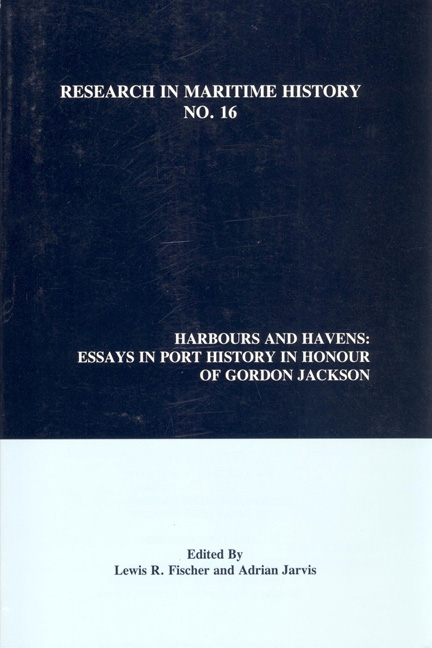Book contents
- Frontmatter
- Contents
- About the Editors
- Contributors
- Introduction
- “Gordon Jackson: An Appreciation”
- “Port History: Some Thoughts on Where it Came from and Where it Might be Going”
- “Port Politics: Interest, Faction and Port Management in Mid-Victorian Liverpool”
- “Our Little Company:' The Wilsons and North Eastern Railway Shipping Company Limited, 1906-1935”
- “The Changing Functions of a Rural Port: Dumfries, 1700-1850”
- “Australian Ports Since 1945”
- “Aspinall, Cornes and Company and the Early Development of the Port of Yokohama”
- “Dubai: From Creek to Global Port City”
- “New York's German Suburb: The Creation of the Port of Bremerhaven, 1827-1918”
- “Capital and Labour in the Port Town of Esbjerg, 1945- 1999”
- “Port Policies: Seaport Planning around the North Atlantic, 1850-1939”
- “Gordon Jackson: A Bibliography”
“Aspinall, Cornes and Company and the Early Development of the Port of Yokohama”
- Frontmatter
- Contents
- About the Editors
- Contributors
- Introduction
- “Gordon Jackson: An Appreciation”
- “Port History: Some Thoughts on Where it Came from and Where it Might be Going”
- “Port Politics: Interest, Faction and Port Management in Mid-Victorian Liverpool”
- “Our Little Company:' The Wilsons and North Eastern Railway Shipping Company Limited, 1906-1935”
- “The Changing Functions of a Rural Port: Dumfries, 1700-1850”
- “Australian Ports Since 1945”
- “Aspinall, Cornes and Company and the Early Development of the Port of Yokohama”
- “Dubai: From Creek to Global Port City”
- “New York's German Suburb: The Creation of the Port of Bremerhaven, 1827-1918”
- “Capital and Labour in the Port Town of Esbjerg, 1945- 1999”
- “Port Policies: Seaport Planning around the North Atlantic, 1850-1939”
- “Gordon Jackson: A Bibliography”
Summary
Any attempt to provide an overview of the emergence of Japanese deepsea ports needs to take account of a number of factors. These include the special topography of the archipelago, its unique history and the difficulties encountered when it was decided that its era of seclusion had to end. This essay will therefore survey these aspects to provide some perspective on the establishment and initial growth of what was to become the port of Yokohama. It will rely to a great extent on a case study of Aspinall, Cornes and Company, a pioneer expatriate mercantile firm in the city.
Japan consists of four main islands - Hokkaido, Honshu, Shikoku and Kyushu - which extend for over 2000 kilometres. This variation in latitude results in considerable climatic differences, so that while northern Hokkaido is sub-arctic, southern Kyushu is nearly tropical. The total land mass is approximately fifty percent more than the UK, although only about one-fifth of the land can be farmed, with wet-rice being the most important crop by far. The limited amount of flat area has also had the effect of concentrating the population into a coastal strip which runs from the Kantö Plain, around Tokyo, through to the Kansai Plain, which includes the cities of Osaka, Kobe and Kyoto. As a result of these factors, it was predictable that when deep-water harbours were required they would be situated mainly in this region.
Although some claim that the first emperor of Japan was a descendent of the Sun Goddess and ruled in 600 BC, it was not until the seventh century that the head of the Yamato clan adopted the title. Subsequent emperors exercised both political and religious authority in the central regions of Japan, but as their military powers declined, others found it convenient to rule in their name. This process came to a head in 1185 and thereafter Japan had a dual system, with the reigning emperor based in Kyoto and a shogun, who exercised real power, located elsewhere.
The ensuing four centuries were marked by a series of power struggles and civil wars between conflicting hans, or extended families, and it was not until late in the sixteenth century that the country was finally pacified.
- Type
- Chapter
- Information
- Harbours and HavensEssays In Port History In Honour Of Gordon Jackson, pp. 139 - 158Publisher: Liverpool University PressPrint publication year: 1998

